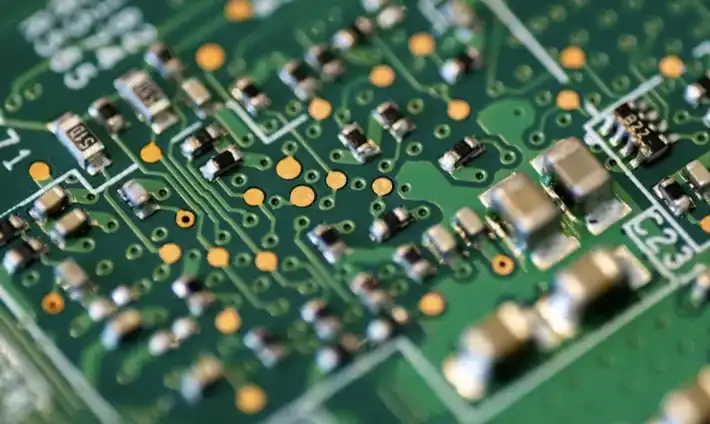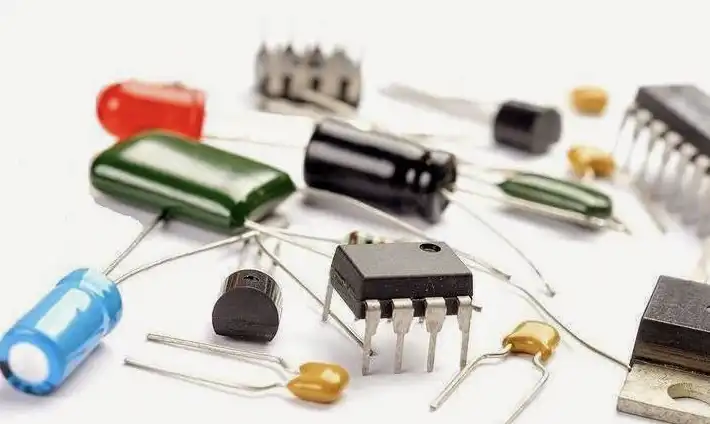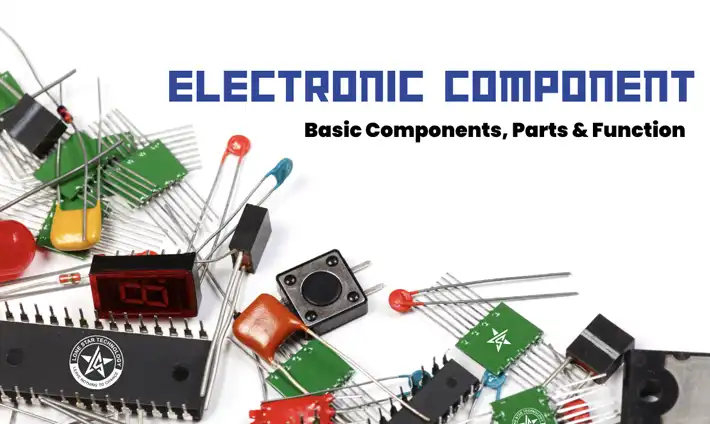Electronic components are the building blocks of modern technology, powering devices we use daily. Understanding how these components work is crucial in comprehending the intricacies of electronic systems.
Electronic Components Definition

Electronic components are individual units or parts that manipulate electrical signals within electronic circuits.
These components can control the flow of current, store energy, amplify signals, or perform other functions essential for the operation of electronic devices. Examples of electronic components include resistors, capacitors, inductors, diodes, transistors, and integrated circuits.
These components play a vital role in modern technology, enabling the functionality of various electronic devices and systems that we use in our daily lives.
All Basic Electronics Components

Basic electronic components are fundamental elements used in electronic circuits to perform specific functions. Understanding these components is essential for anyone interested in electronics or electrical engineering. Here’s an overview of some common basic electronics components:
1. Resistors:
- Resistors are passive components that limit the flow of electrical current in a circuit.
- They are commonly used to control the amount of current, voltage, or power in a circuit.
- Resistors are available in various values and power ratings, and they are often represented by color codes to denote their resistance value.
2. Capacitors:
- Capacitors store and release electrical energy in the form of an electric field.
- They are used to filter noise, smooth voltage fluctuations, and block DC signals while allowing AC signals to pass through.
- Capacitors come in different types, including electrolytic, ceramic, and tantalum capacitors, each suited for specific applications.
3. Inductors:
- Inductors are passive components that store energy in the form of a magnetic field when current flows through them.
- They resist changes in current flow and are used in circuits to filter signals, block AC signals, or store energy.
- Inductors are commonly found in power supplies, filters, and oscillators.
4. Diodes:
- Diodes are semiconductor devices that allow current to flow in one direction while blocking it in the opposite direction.
- They are used as rectifiers to convert AC to DC, as voltage regulators, and in signal demodulation and switching applications.
- Diodes come in various types, including silicon, germanium, Schottky, and Zener diodes, each with specific characteristics and applications.
5. Transistors:
- Transistors are semiconductor devices used for amplification, switching, and signal modulation.
- They consist of three layers of semiconductor material and can be either bipolar junction transistors (BJTs) or field-effect transistors (FETs).
- Transistors are the building blocks of electronic circuits and are widely used in amplifiers, digital logic circuits, and power control systems.
6. Integrated Circuits (ICs):
- Integrated circuits are miniature electronic circuits fabricated on a single semiconductor chip.
- They contain thousands to millions of electronic components, including transistors, resistors, capacitors, and diodes, interconnected on a small silicon wafer.
- ICs come in various types, such as microprocessors, memory chips, operational amplifiers, and sensors, and they are used in virtually all electronic devices, from smartphones to computers to automotive systems.
Types of Components

Active vs Passive Components
Active components, like transistors, require an external power source to function, whereas passive components, such as resistors and capacitors, do not produce energy gain.
Common Types: Resistors, Capacitors, Inductors, Diodes, Transistors, and Integrated Circuits
Resistors limit current flow, capacitors store and release electrical energy, inductors resist changes in current flow, diodes allow current flow in one direction, transistors amplify or switch electronic signals, and integrated circuits contain multiple components in a single package.
How Electronic Components Work

Electronic components work by manipulating the flow of electrical current within electronic circuits to perform specific functions. Each component has a unique role and behavior that contributes to the overall operation of the circuit. Here’s a brief explanation of how some common electronic components work:
1. Resistors:
- Resistors restrict the flow of electrical current in a circuit by introducing resistance.
- They do this by converting electrical energy into heat as current passes through them, following Ohm’s law (V = IR).
- Resistors are used to control the amount of current in a circuit, limit voltage, divide voltage, or act as voltage or current sensors.
2. Capacitors:
- Capacitors store and release electrical energy in the form of an electric field between two conductive plates separated by an insulating material (dielectric).
- When voltage is applied across a capacitor, it charges up, storing energy. When the voltage is removed, the capacitor discharges, releasing stored energy.
- Capacitors are used for filtering, coupling, decoupling, timing, and energy storage in circuits.
3. Inductors:
- Inductors store energy in the form of a magnetic field when current flows through them.
- The magnetic field induces a voltage (back EMF) that opposes changes in current, leading to properties such as self-inductance.
- Inductors are used to filter signals, store energy, and block AC signals while allowing DC signals to pass.
4. Diodes:
- Diodes are semiconductor devices that allow current to flow in one direction (forward bias) while blocking it in the opposite direction (reverse bias).
- They have a p-n junction that conducts current when forward biased and acts as an open circuit when reverse biased.
- Diodes are used in rectification, voltage regulation, signal demodulation, and switching applications.
5. Transistors:
- Transistors are semiconductor devices with three terminals (emitter, base, collector for BJTs; source, gate, drain for FETs) that amplify or switch electronic signals.
- By controlling the flow of current between two terminals (collector and emitter for BJTs; source and drain for FETs) using the third terminal (base for BJTs; gate for FETs), transistors amplify signals in amplifiers and act as switches in digital circuits.
6. Integrated Circuits (ICs):
- Integrated circuits (ICs) contain multiple electronic components, such as transistors, resistors, capacitors, and diodes, fabricated on a single semiconductor chip.
- They perform complex functions, such as processing, amplification, signal conditioning, and memory storage, in various electronic devices.
- ICs are essential components in modern electronics, providing high levels of integration, performance, and reliability.
Knowing how these electronic components work is essential for designing, analyzing, and troubleshooting electronic circuits effectively. By grasping their principles of operation, engineers and hobbyists can create innovative electronic systems and devices for diverse applications.
FAQs
What are the main types of electronic components?
The main types of electronic components include resistors, capacitors, inductors, diodes, transistors, and integrated circuits. These components play crucial roles in electronic circuits, enabling various functions and applications.
How do resistors regulate current flow?
Resistors regulate current flow by impeding the flow of electrical current in a circuit. They do this by converting electrical energy into heat as current passes through them, effectively limiting the amount of current that can flow.
What is the purpose of an integrated circuit?
The purpose of an integrated circuit (IC) is to integrate multiple electronic components, such as transistors, resistors, capacitors, and diodes, onto a single semiconductor chip. This integration allows for compact, high-performance electronic systems and devices.
Can electronic components be recycled?
Yes, electronic components can be recycled. Recycling electronic components helps recover valuable materials and reduces environmental pollution associated with electronic waste disposal. Many electronic components contain precious metals and other recyclable materials that can be reused in manufacturing processes.
How do capacitors store energy?
Capacitors store energy by storing electric charge between two conductive plates separated by an insulating material (dielectric). When a voltage is applied across a capacitor, charge accumulates on the plates, creating an electric field. This stored energy can be released when needed, making capacitors useful for energy storage and voltage regulation in electronic circuits.
What safety precautions should I take when working with electronic components?
When working with electronic components, it’s essential to observe safety precautions to prevent electrical shocks, component damage, and other hazards. Some safety measures include wearing appropriate protective gear, such as safety goggles and gloves, working in a well-ventilated area, ensuring circuits are de-energized before handling, and following proper handling and disposal procedures for electronic waste.
Conclusion
Understanding how electronic components work is essential for anyone interested in technology or engineering. By grasping the fundamentals of electronic systems, individuals can appreciate the marvels of modern innovation and contribute to future advancements.